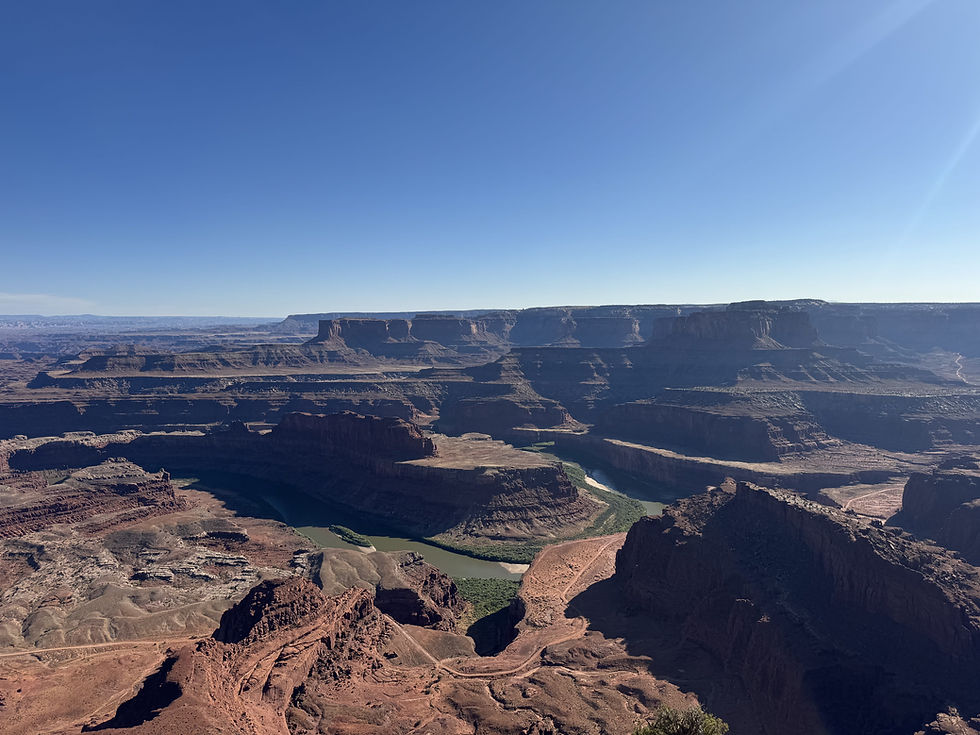Capitol Reef & Bryce Canyon: Pies, Petroglyphs and Snowy Hoodoos
- campsidephotos
- Sep 8
- 3 min read
With John still along for the ride, the three of us set our sights on two more national parks—Capitol Reef and Bryce Canyon. Each stop had its own personality: Capitol Reef with its rugged red rocks, hidden history, and the ever-present reminder of flash floods, and Bryce with its surreal spires and snowy, otherworldly beauty.
Capitol Reef: Flash Floods, Pies & Petroglyphs
Capitol Reef is one of those places that feels almost impossible to describe. It’s named for the white sandstone domes that resemble the U.S. Capitol, and the “reef” part comes from the sheer cliffs that acted like barriers to early travelers. Driving through, you feel like an ant—tiny and insignificant—compared to the towering rock walls that surround you.
We hiked the Capitol Gorge Trail, which was beautiful and winding, but I’ll admit: the constant thought of flash flooding sat heavy in the back of our minds. You hear enough stories about how quickly water can come roaring through these canyons, and suddenly every cloud looks a little suspicious. Still, the beauty was worth every cautious glance upward.
Afterward, we made the most important stop of the park—the Gifford Homestead. Originally settled in the early 1900s, the Gifford family lived and farmed here in the Fruita Valley, leaving behind orchards that still produce fruit today. The farmhouse has been restored into a little museum and gift shop, but the real treasure? The pies. We bought one of each flavor, because why not? And as I’ve said before, I’m not even a pie person… but these pies? Game-changers. Hands down, the best pies I’ve ever had.
We timed our evenings around the sunsets, because Capitol Reef is magic when the light hits just right. As the sun dipped, the red cliffs glowed like fire before fading into soft pinks—it was the kind of view that makes you forget about everything else.
We also stopped to see the petroglyphs carved into the rock by the Fremont people centuries ago. We’re always fascinated by these ancient carvings, but there’s a bittersweet edge: we can admire the figures and symbols, but the stories they tell are lost to us. We stared, wondering, wishing we knew.
On the quirkier side, Capitol Reef is also dotted with abandoned uranium mines from the mid-20th century, back when people thought radioactive ore was the ticket to riches. Today, the boarded-up shafts sit quietly in the cliffs—a strange reminder of another era.

Bryce Canyon: Snow & Hoodoos
From there we made a quick stop at Bryce Canyon National Park. The park is famous for its hoodoos—those spindly, otherworldly rock formations that look like they belong in a fantasy novel. Seeing them dusted with snow made it even more surreal, like we’d stumbled into a frozen alien world.
John, determined to get the best view possible, braved a snow-packed trail up to the Agua Canyon Overlook, which sits at about 8,800 feet in elevation. Watching him climb while Patrick and I stayed warm made us laugh—sometimes you’ve got to let the eager one go get the bragging rights.
We drove the park road, stopping at every open overlook. Each one felt like stepping onto the edge of another planet. We knew right away that Bryce was one of those places we’d have to come back to—it deserves more time, more hikes, and probably warmer weather.

Between Capitol Reef’s glowing cliffs, pie-fueled evenings, mysterious petroglyphs, and Bryce Canyon’s snow-dusted hoodoos, this stretch of the trip was unforgettable. It was the perfect mix of laughter, awe, and just a touch of danger (because nothing says adventure like flash flood warnings and uranium mines). Traveling with John made it even better—sometimes the best views are the ones you get to share.





Comments